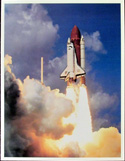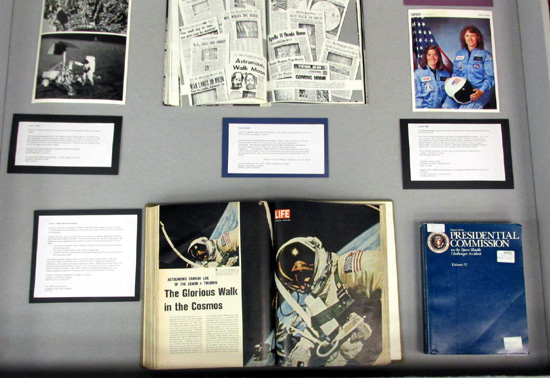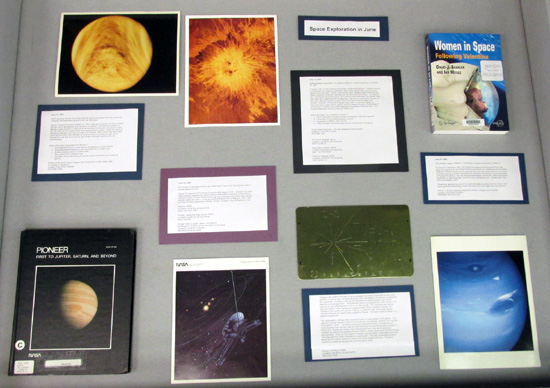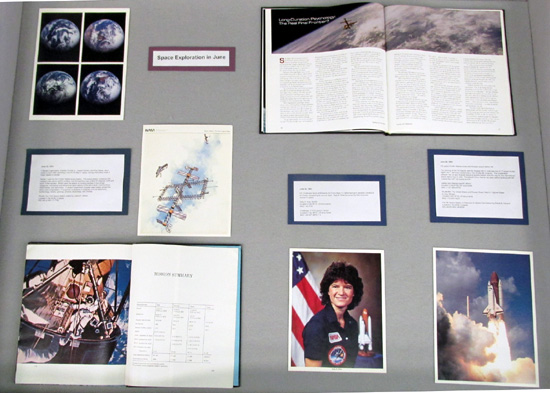
June 2015
The New York State Library's June public floor exhibit commemorates the anniversaries of several milestones in both the American and the Soviet space programs that took place in June, including the 50th anniversary of Gemini 4 and the first spacewalk by an American astronaut. Items on display include books from the general collection, and photos and publications from the Federal Documents collection.
June 2, 1966: Surveyor I makes successful soft landing on the moon and begins to relay first close-up images.
The Surveyor series was NASA's first attempt to land a spacecraft on a planetary body other than earth. This was the second stage in NASA's triad system of unmanned lunar explorations, preceded by the Ranger series and followed by the Lunar Orbiter series. The final photos from the five crafts were transmitted in 1968; together, all five had relayed a total of 87,674 images of the moon to earth.

June 3, 1965: James A. McDivitt and Edward H. White II make 66 orbits of earth (four days) in Gemini 4. White takes first spacewalk by an American and maneuvered for 20 minutes outside of the capsule. (50th anniversary)
Projects Mercury, Gemini, and Apollo were a series of programs designed to execute the human space flight imperative. The Gemini program, the second in the series, was designed to gain experience that would be required to make a lunar landing in three fields:
The Gemini program made a total of 10 manned flights between March 1965 and November 1966, giving NASA nearly 2000 man-hours in space and developing rendezvous and docking techniques essential to Apollo. NASA learned from Gemini 7 that astronauts had the ability to remain in orbit for durations up to two weeks without serious medical problems. Later flights showed the importance preparing for zero-gravity operations outside of the spacecraft by using neutral buoyancy training.
June 6, 1966: Gemini 9 splashes down after a 44 orbit trip (3 days) and a record spacewalk of two hours and nine minutes by Eugene A. Cernan.
"Gemini gave us the confidence we needed in complex space operations, and it was during this period that Chris Kraft and his team really made spaceflight operational. They devised superb techniques for flight management, and Mission control developed to where it was really ready for the complex Apollo missions... The success of these operations and the high spaceflight activity kept public interest at a peak, giving out national leaders the broad supporting interest and general approval that made it possible to press ahead with a program of the scale of Apollo."
-Robert R. Gilruth, "I Believe We Should Go to the Moon"
June 7, 1971: Soyuz 11 docks in earth orbit with Salyut space station and lab experiments commence.
Cosmonauts Georgy Dobrovolsky, Vladislav Volkov, and Viktor Patsayev became the world's first occupants of a space station. The mission set a new space endurance record of 570 hours and 22 minutes (24 days) during the cosmonauts' occupation of Salyut. Unfortunately, all three perished 30 minutes before landing back on earth due to a sudden drop in air pressure when the ship's seals failed.
June 9, 1986: US presidential panel issues report blaming NASA for the Challenger accident due to an unnoticed gas leak.
The Space Shuttle Challenger is the second reusable spacecraft in history. One of its crew members was Christa McAuliffe, a teacher who was going to conduct lessons in space that would be broadcasted to classrooms around America. Barbara Morgan was also part of the teachers in space program. Unfortunately, on January 28, 1986 the Challenger exploded seconds after lift-off for Mission 51-L. All seven of the crew members died, including McAuliffe.

June 12, 1967: Soviet Venera 4 is launched.
The capsule landed on Venus by parachute on October 18, 1967.
The president of the Soviet Academy of Sciences, Academician Mistilav V. Keldysh reached out to the director of England's Jodrell Bank Observatory, Sir Bernard Lovell, for help in gathering the information Venera 4 sent back to earth. Keldysh stated that the Soviet mission would be "of primary importance for the entire world of science."
On October 18, Lovell tracked Venera 4's signal with a powerful radio-telescope. He received a two-tone signal that registered as the Soviet probe. After an hour and twenty minutes, the tone when silent as Venera 4 entered Venus' atmosphere and the signal was blocked. A weaker, different set of signals began after 15 seconds. Some information transmitted from Venera 4:
Before its destruction upon impact with the planet, Venera 4 passed through a 15-mile layer of scorching hot turbulence with winds measured at hundreds of miles per hour. The Russians described the environment as "hellish fires."
June 13, 1983: US Pioneer 10 becomes the first man-made object to leave the Solar System when it crosses Neptune's orbit.
Pioneer 10 was part of the Pioneer Program which began in 1957. Pioneers 6 through 9 (1965-1968) explored interplanetary space, millions of kilometers inside and outside Earth's orbit, but Pioneer 10 was the first space craft commissioned to go to the outer planets, namely Jupiter and Saturn. It was launched at 8:49 pm EST on March 2, 1972. More than ten years later, after enduring the asteroid belt and radiation, Pioneer 10 made it beyond Neptune's orbit.
A plaque was added to Pioneer 10 as a message to possible inhabitants of other solar systems. At the far right, the bracketing bars show the height of the woman compared to the spacecraft. The figure in the top left represents a reverse direction spin of the electron in a hydrogen atom. This transition puts out a characteristic radio wave 21 cm long, so we are indicating that 21 cm is our base length. The horizontal and vertical ticks around the human figures are a representation of the number 8 in binary form. Therefore, the woman is 8 x 21 cm =168 cm, or about 5'5" tall. The human figures represent the type of creature that created the Pioneer. The man's hand is raised in a gesture of good will.
The radial pattern will help other scientists locate our solar system in the galaxy. The solid bars indicate distance, with the horizontal bar, denoting the distance from the Sun to the galactic center. The shorter solid bars represent direction and distances to various pulsars from our Sun, and the ticks following them are the periods of pulsars in binary form. Pulsars are known to be slowing down and if the rate of slowing is constant, an other-world scientist should be able to roughly deduce the time the Pioneer was launched. Thus, we have placed ourselves approximately in both space and time. The drawing at the bottom indicates our solar system. The ticks accompanying each planet are the relative distance in binary form of the planet to the Sun. Pioneer's trajectory is shown as starting from the third planet, Earth.
June 14, 1967: NASA launches Mariner 5, two days after the launch of Venera 4, with the intention of collecting Venusian data during a 2,200 mile flyby pass.
Mariner 5 passed Venus on October 19, 1967, a day and a half after Venera 4 passed through Venus' atmosphere and crashed on the planet. The data transmitted from Mariner 5 was collected by radio waves as the probe hurtled past the planet at nearly 20, 000 miles per hour about 2,400 miles away from the surface. Nearly two hours of data were collected, some of it coming in live to NASA.
Some information transmitted from Mariner 5:
Much of the data transmitted confirmed that which was collected by Venera 4 when it travelled through Venus' atmosphere, and that which did not was handled extremely cautiously by US spokespeople.
June 16, 1963: First female in space, Valentia V. Tereshkova, is launched into orbit in Vostok VI.
By the end of December 1961, the Central Committee of the Communist Party had given their approval for recruitment of more cosmonauts; five of these would be women. Valentina Tereshkova was only 24 years old when she was picked to be one of the five. The idea of having a female cosmonaut and putting the first woman in space appealed to Premier Khrushchev. He saw this as a demonstration of how the Communist System could train an "above average" worker for such a demanding role. He also saw it as a blow to the western world.
Tereshkova reported that one of her most memorable moments from the mission was looking at Earth and thinking it was a lot smaller and more fragile than she expected.

June 22, 1973: Three Skylab 2 astronauts, Charles Conrad Jr., Joseph Kerwin, and Paul Weitz, return safely to earth after spending a record 28 days in space, during which they made two major repairs to Skylab.
Skylab 1 was the first United States space station. The space station orbited at 235 nautical miles above earth's surface, and its trajectory was plotted 50 degrees north and south of the equator. NASA used the station to conduct studies in four broad categories: biomedical and behavioral observations of the astronauts; man/machine relationships; and astronomy. A student experiment program was hosted aboard the station and broadcasted 17 programs to students in subjects such as astronomy, bacteriology, botany, geology, physics, physiology, and zoology.
June 24, 1983: US Challenger lands at Edwards Air Force Base in California due to weather conditions in Florida, completing its second flight. Sally K. Ride becomes the first American woman in space.
June 29, 1995: US space shuttle Atlantis docks with Russian space station Mir.
The docking of the US Atlantis with the Russian Mir in June was one of eleven space shuttle flights and seven astronaut residencies in the Shuttle-Mir program. The cooperation between the US and Russian space programs helped pave the way for the international space station now in orbit. The takeoff of the Atlantis two days before docking with Mir marked the 100th US space launch.
The smaller cases by the elevators displayed additional photographs from NASA, including images of planets in our solar system, as well as items that illustrate the role that space travel has in popular culture.
Other Books on Display
Exhibit curated by Emily Kinney and Emily Weirzbowski.